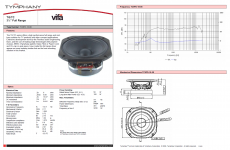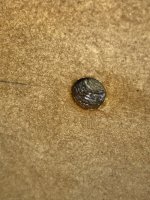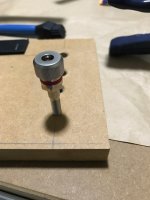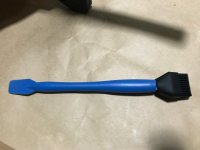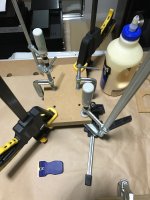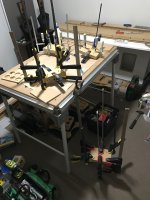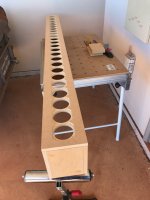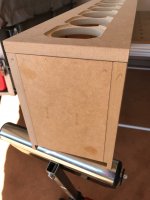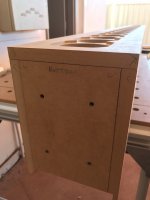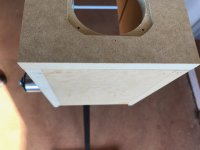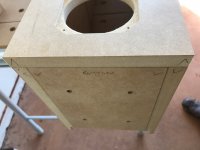It's spec is (un)clear about it, it's obviously not measured over 20 Hz to 20 KHz.
Rev 1.0 from Tymphany (10 sept '09) datasheet says: 5 watt over 120 Hz to 10 KHz 12 dB crossovers (IEC 2685 18.1)
Rev 2 from Tymphany (18 jul '12) datasheet says: 30 watt from 100 Hz to 20 KHz 12 dB crossovers (IEC 2685 18.1)
Rev 3 from Tymphany (28 apr '15) datasheet says: 30 watt from 100 Hz to 20 KHz no mention of IEC spec.
Though there has been a cute test by a PA oriented forum member here, BYRTT, do you still have the link handy of what I'm talking about .
.
I have another from Tymphany stating 50 watt (rated noise power, and 100 watt long-term max power)

Rev 1.0 from Tymphany (10 sept '09) datasheet says: 5 watt over 120 Hz to 10 KHz 12 dB crossovers (IEC 2685 18.1)
Rev 2 from Tymphany (18 jul '12) datasheet says: 30 watt from 100 Hz to 20 KHz 12 dB crossovers (IEC 2685 18.1)
Rev 3 from Tymphany (28 apr '15) datasheet says: 30 watt from 100 Hz to 20 KHz no mention of IEC spec.
Though there has been a cute test by a PA oriented forum member here, BYRTT, do you still have the link handy of what I'm talking about
I have another from Tymphany stating 50 watt (rated noise power, and 100 watt long-term max power)
Attachments
Last edited:
...Though there has been a cute test by a PA oriented forum member here, BYRTT, do you still have the link handy of what I'm talking about...
Do you mean Barleywater
Last edited:
No need to kill them, pretty hard to destroy them, these arrays will make a lot of noise on only one watt over a very wide frequency spectrum.  Each driver will see a fraction of that watt.
Each driver will see a fraction of that watt.
Only the bottom end is restricted by power, personally I use a 100 watt amplifier and it delivers more than I expected (and remarkably clean). Especially for music. Each driver still only gets 4 watt max in that case.
For Home theatre some help in the bottom end would be wise. The 240 watt figure I mentioned is based on reaching x-max out to 20 Hz for a single array.
Only the bottom end is restricted by power, personally I use a 100 watt amplifier and it delivers more than I expected (and remarkably clean). Especially for music. Each driver still only gets 4 watt max in that case.
For Home theatre some help in the bottom end would be wise. The 240 watt figure I mentioned is based on reaching x-max out to 20 Hz for a single array.
Do you mean Barleywaterhe did some TC9 torture here http://www.diyaudio.com/forums/full...-performace-testing-platform.html#post4397343
also weltersys did some mild torture with over 800 watts before letting out the magic smoke http://www.diyaudio.com/forums/mult...lti-way-point-source-horn-19.html#post4581881
I was getting at that 800 watt torture test
I don't plan to have a double baffle at this point but it is still possible to be retrofitted later if I felt it was needed.
I also really wanted to make a curved cabinet using the frame and laminated ply sheets, partly because I have a few sheets of 3mm luan ply that I got for nothing, turned out to be too much work at this point though.
Congrats with super thread, I will follow this. I designed the DTP-towers adressed above. Just to clearify: Glue sealants as for example CT1 are suberb for driver fixing. You shall provide brute force for loosen the drivers. I even made a 10 wine-bottle rack using this stuff not using a single screw. The external front baffle rested on visco-elastic foil not allow any vibrations to appear. Same foil vere used as gaskets under the driver flanges. The baffle did not touch the drivers flanges (no clamping effect).
Whish you success and a sound... result
I've glanced at it and think I understand what it is they do. I'd rather take multiple measurements at slightly different spots and averaging them to isolate the speaker from the room. And battle any reflection found as much as one can with old fashioned means.
I still prefer frequency dependent windowing as a means of gating. It's still gating, but a different gate at each frequency and gives a more clear view of the first wave front.
We want to correct the speaker and adjust to the room. Those are two different things. We cannot loose the room completely (at least not all of us) but can diminish it's influence.
If you want to EQ the room and speaker a little at low frequencies it would probably make it harder. Still think it would be interesting to try virtually to see what it does.
I think it has more utility in conjunction with ground plane or outdoor measurements if you want more accurate very low frequency measurements where even anechoic chambers are limited.
It would be interesting for a near field setup where you are trying to remove the room contribution to measurements.
Maybe Byrtt could give it try with some of his near field speaker measurements?
Looking forward to the rest of your build and impressions Fluid! I found your thoughts on actual drum sets vs recordings very interesting. More and more I'm starting to believe that the ear/brain hearing mechanism is a waveform analyzer rather than a frequency analyzer. I think it's a possibility that the importance of a good impulse response (a very fast rise time is what I'm starting to believe is very important) is overlooked, and thankfully the TC9's look excellent for this. I came across a video today that the ear has a time resolution of 7 microseconds! I really hope the array gives you an impression of more realistic hi-hats.
Thanks! I think the recording process has more to do with the difference between real and recorded when it comes to drums. I don't mind the change in timbre so much from the processing as it can still be enjoyable but the panning I find odd. Distance and masking play a big role in the acoustic sound too. A real drum kit in a small reflective room results in a very strong impression of every part of the sound. When you move 20 to 30 metres away the sound changes and when you add guitar amps over the top different again.
Hours and hours of solo practice probably ingrains these differences in.
I have been listening to the 30th Anniversary Collection by Whitesnake, interesting to see how the drum sound changes quite considerably over the three discs.
I am also looking forward to see what a full range a time coherent speaker with no crossover sounds like. Still a way to go yet though.
Those data seems to differ a bit between the various datasheet versions released over the years, have datasheets from 2009 where they branded VIFA and while power handling for both models was at 30W, TC9 had only 1,50mm Xmax where TG9 had 2,35mm.
Attached below is new version where they branded Peerless and Xmax is now 2,6mm for both models, efficiency is closer than ever, but TG9 have 5W lower power handling.
In a ~2L cabinet the TC9 is very much x-max limited at about 15W even on the more generous 2.6mm spec.
If you put it in a very small cabinet then the thermal rating could be more relevant, or on a horn like Art did.
So hard to know what any manufacturer spec means as there are so many different 'standards'.
The latest TC9 sheet lists Rated noise power which should mean
"2.c. The IEC268-5 (1978) standard
This is a standard by the International Electrotechnical Commission from 1978 and reaffirmed in the eighties. It specifies a 6 dB crest factor pink noise signal over which an IEC programme filtering has been applied. This programme spectrum tries to approximate the frequency content of real music, and shows reduced lows and highs. The illustration compares this spectrum to the AES ones. The terms "Rated noise power" and "power handling capacity" are used.
Test duration is 100 hours, after which the speaker should not show appreciable damage.
NOTE: To make matters more confusing, there's another 268-5 standard from 1972 that specifies a different signal spectrum and time, but this is rarely used"
The red line on this graph
Information from here
Speaker power handling < Pro-Audio References
Attachments
Last edited:
Congrats with super thread, I will follow this. I designed the DTP-towers adressed above. Just to clearify: Glue sealants as for example CT1 are suberb for driver fixing. You shall provide brute force for loosen the drivers. I even made a 10 wine-bottle rack using this stuff not using a single screw. The external front baffle rested on visco-elastic foil not allow any vibrations to appear. Same foil vere used as gaskets under the driver flanges. The baffle did not touch the drivers flanges (no clamping effect).
Whish you success and a sound... result
Thanks, your build was very impressive! I think I read that you sold them afterwards. Was that due to not liking them or some other reason?
Good to hear that the glue is strong enough. I think clamping might have been a bad description but I still think that the outer baffle with the damping in between will help to support the drivers a little and put less pressure on the glue joint.
I am always sceptical of glue only as I have had a number of glue failures in odd points over time particularly with construction adhesives. They are great initially and can't be pulled apart without a lot of force but over time this changes and sometimes the joint just pops apart.
Time zone differences seem to mean that I am posting a lot of replies in a row!
More progress
It turns out that you really cannot have enough clamps!
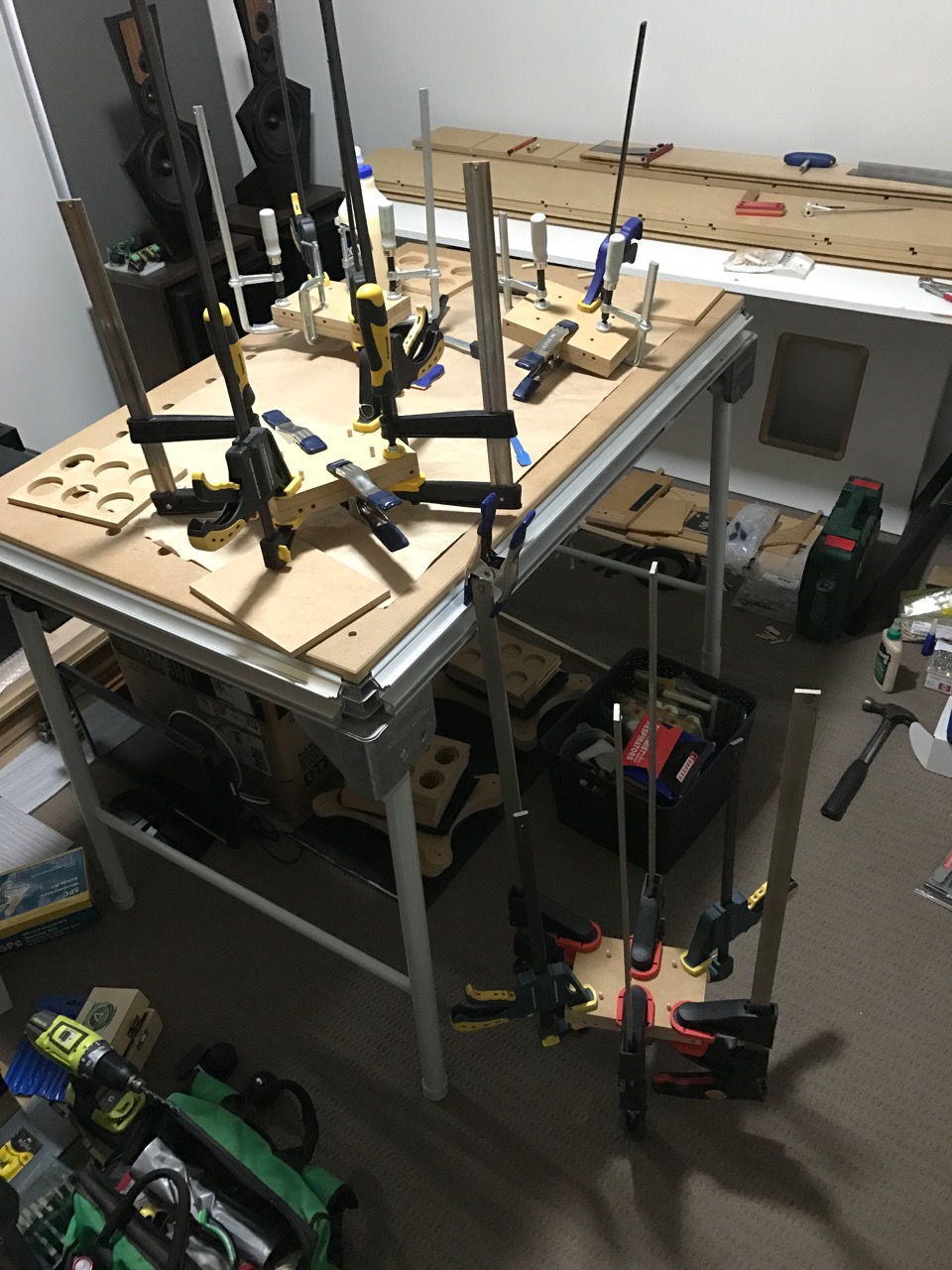
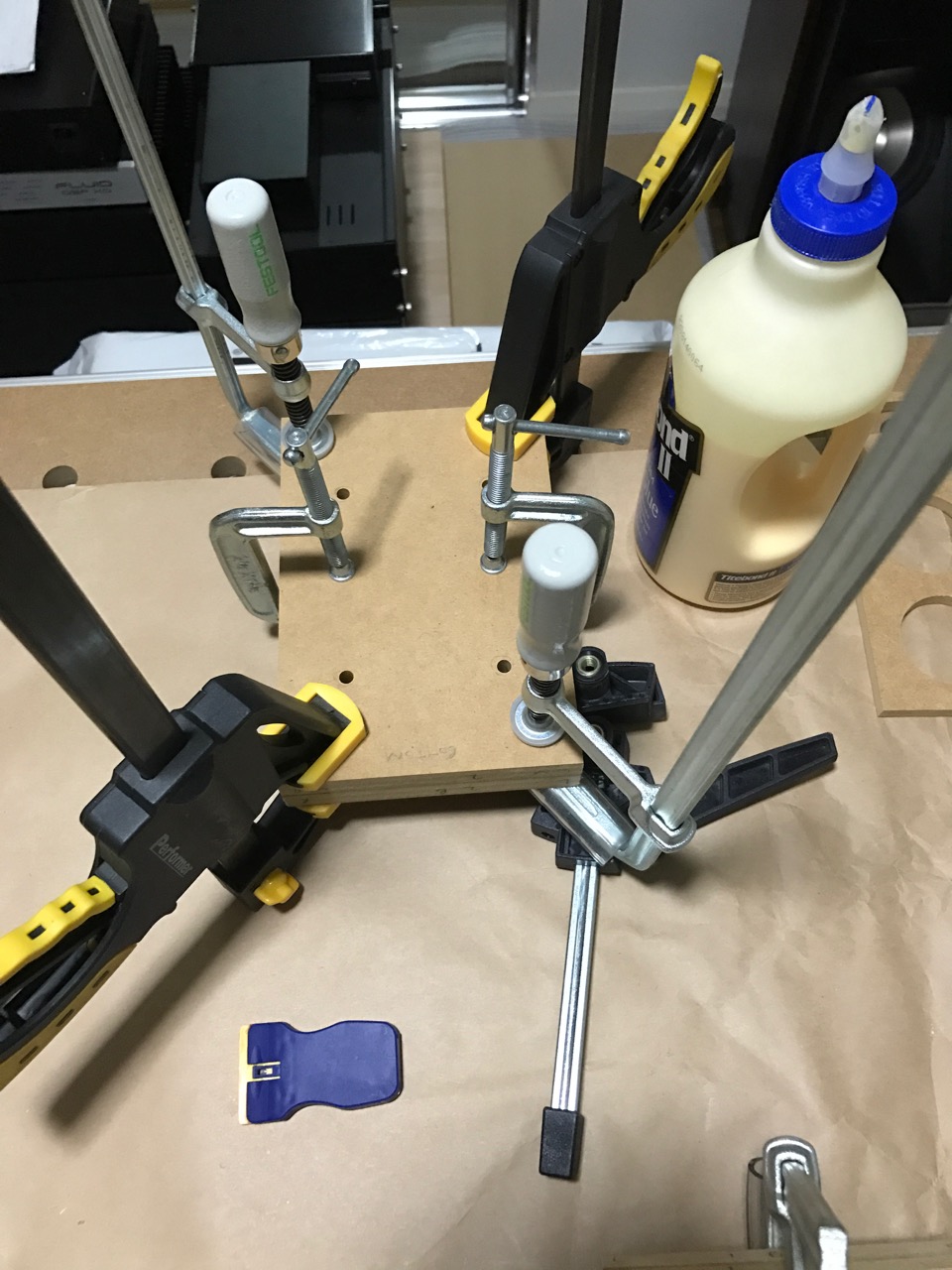
A silicone glue spreader is a very good accessory to have when gluing panels together.
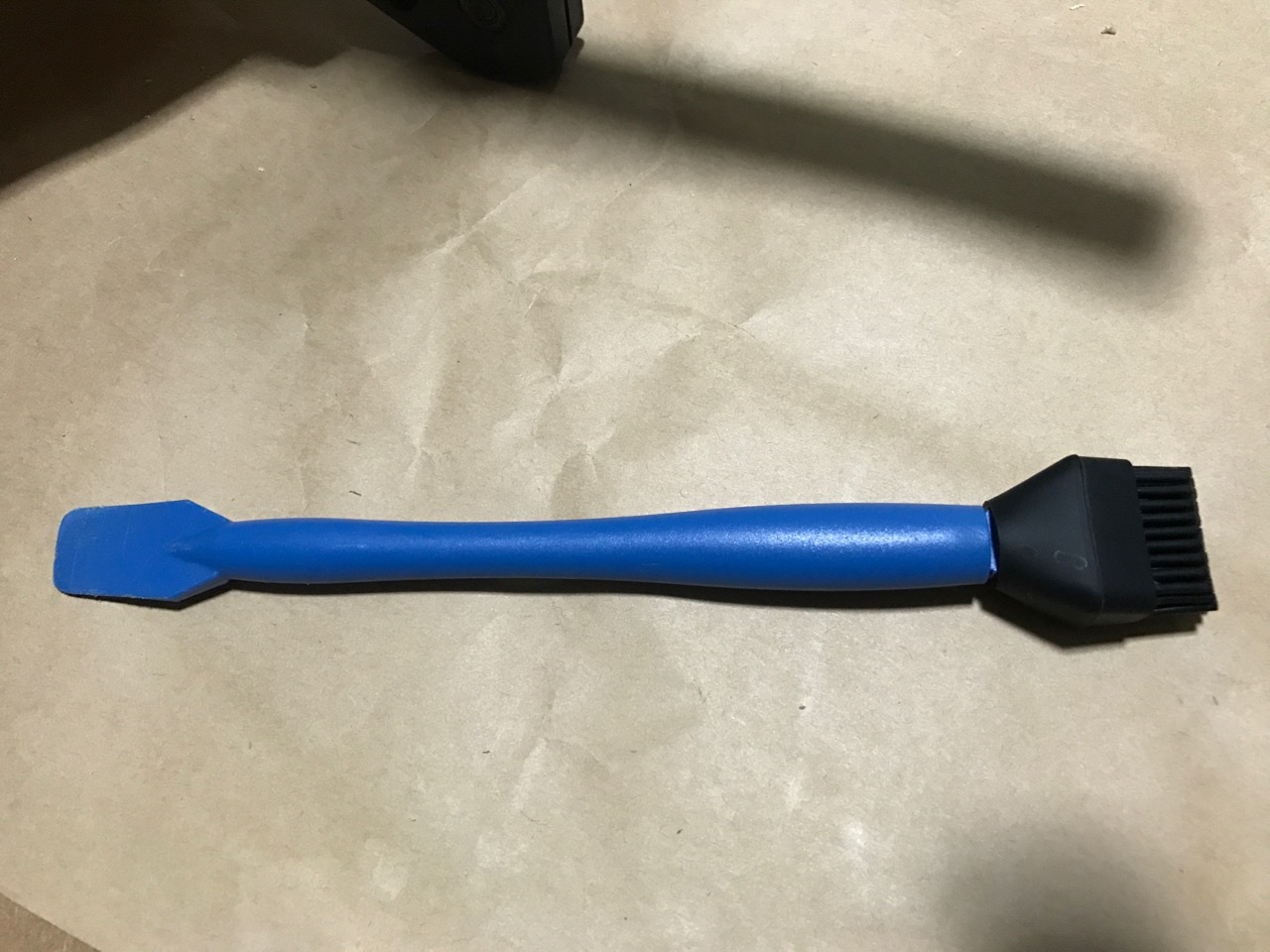
I made a test to tap the MDF for installing the binding posts. With some superglue added to strengthen the threads I needed to use a spanner to get more than halfway through the thread, very strong indeed. I think I will re-tap after the glue to make it a bit easier to install in the final panels.
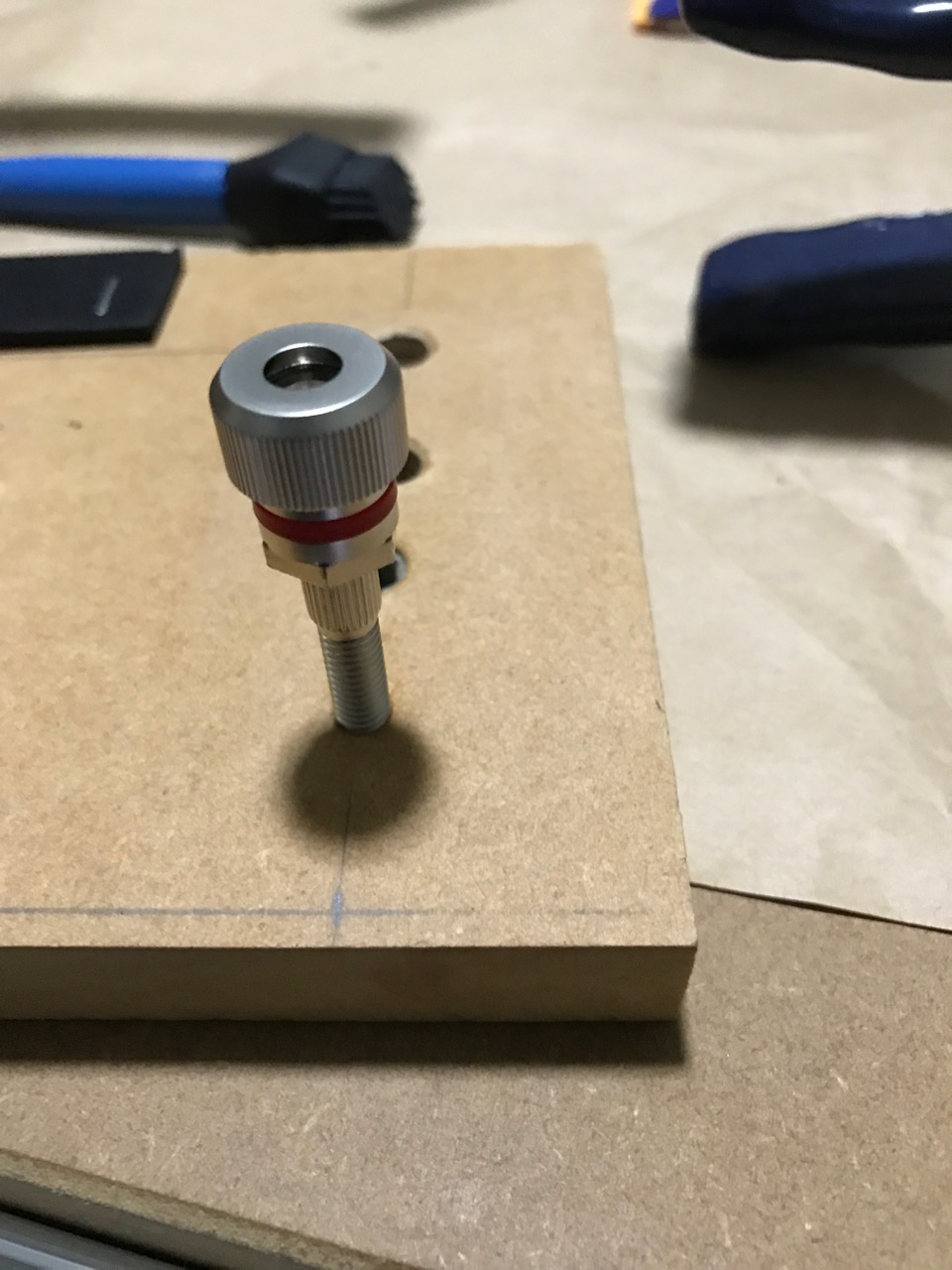
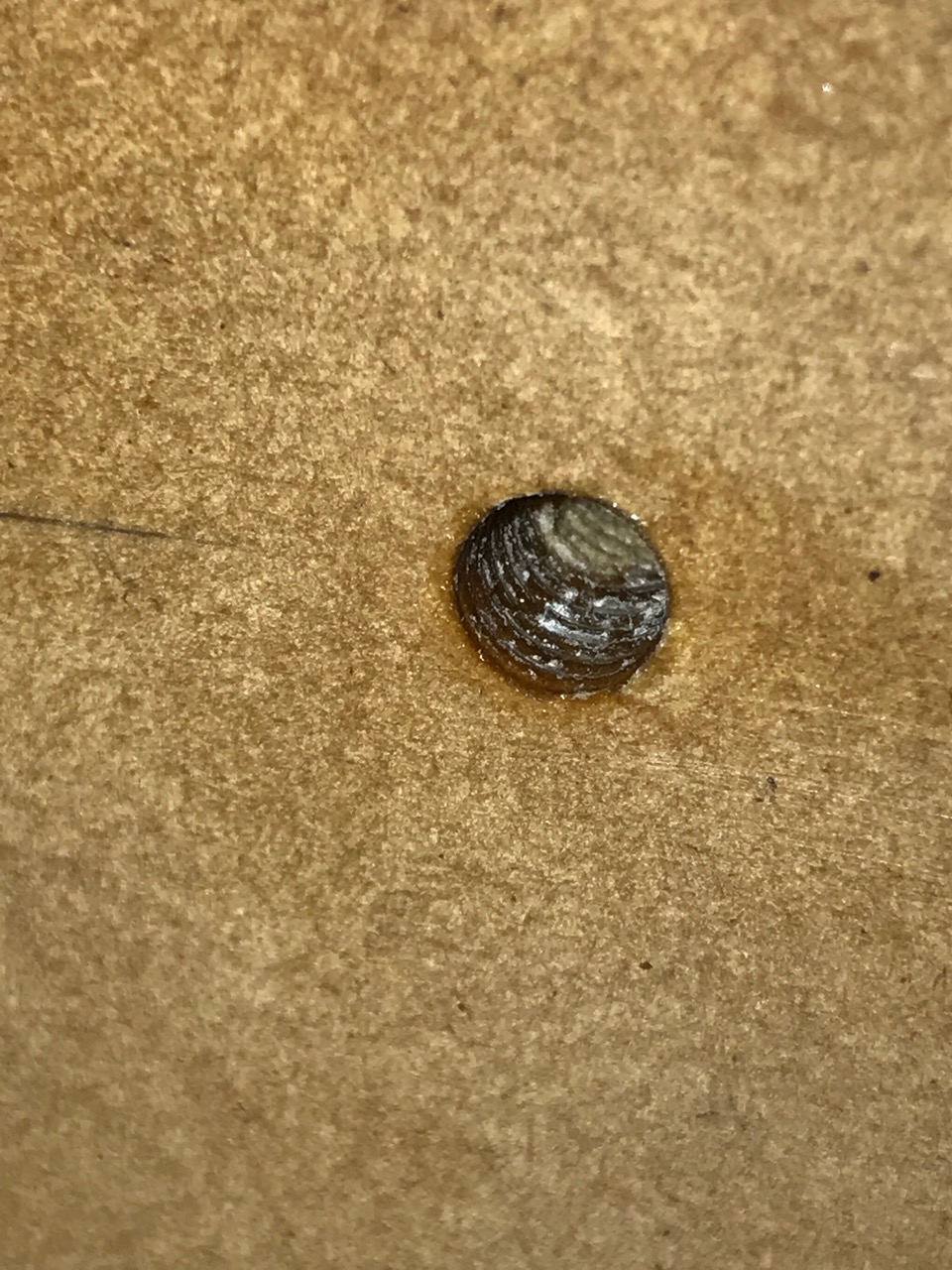
More progress
It turns out that you really cannot have enough clamps!
A silicone glue spreader is a very good accessory to have when gluing panels together.
I made a test to tap the MDF for installing the binding posts. With some superglue added to strengthen the threads I needed to use a spanner to get more than halfway through the thread, very strong indeed. I think I will re-tap after the glue to make it a bit easier to install in the final panels.
Attachments
If you want to EQ the room and speaker a little at low frequencies it would probably make it harder. Still think it would be interesting to try virtually to see what it does.
I think it has more utility in conjunction with ground plane or outdoor measurements if you want more accurate very low frequency measurements where even anechoic chambers are limited.
It would be interesting for a near field setup where you are trying to remove the room contribution to measurements.
Maybe Byrtt could give it try with some of his near field speaker measurements?
Just a note about my fondness of FDW. Even in an anechoic room I'd still use FDW over more traditional gating. I have my reasons.
What I meant about EQ-ing speaker and room, (FIR) EQ the first wave front of the speaker. Look over a longer window to see room effects. Then use gradual EQ to make up for room anomalies. Battling first reflections has the added benefit that the room response pretty much follows the frequency dependent window response. Part of the benefit is the arrays to get us there. People still underestimate the power of averaging out reflections.
Thanks, your build was very impressive! I think I read that you sold them afterwards. Was that due to not liking them or some other reason?
Good to hear that the glue is strong enough. I think clamping might have been a bad description but I still think that the outer baffle with the damping in between will help to support the drivers a little and put less pressure on the glue joint.
I am always sceptical of glue only as I have had a number of glue failures in odd points over time particularly with construction adhesives. They are great initially and can't be pulled apart without a lot of force but over time this changes and sometimes the joint just pops apart.
Hi,
Thanks your comments. The towers were sold to a happy customer (sound technician) due to the owner always eager to build something new. (He is a teacher for furniture carpentry). We created two more pair of line-sources since then and the third and 4th. pair is ongoing. No.3 will be driven by TC9FD18-08 plus Fountec WG and no. 4 will be driven by Fountek FR89EX plus Raal and some integrated SB Subs. This do not create money, but pleasure and some experience. The best one sound-wise by now is an open baffle parabolic (google for "krum-kast").
Keep on your good work !
Hi,
Thanks your comments. The towers were sold to a happy customer (sound technician) due to the owner always eager to build something new. (He is a teacher for furniture carpentry). We created two more pair of line-sources since then and the third and 4th. pair is ongoing. No.3 will be driven by TC9FD18-08 plus Fountec WG and no. 4 will be driven by Fountek FR89EX plus Raal and some integrated SB Subs. This do not create money, but pleasure and some experience. The best one sound-wise by now is an open baffle parabolic (google for "krum-kast").
Keep on your good work !
You must like line arrays then! I have always thought that a two way would use bigger low frequency drivers, ribbons seem popular for tweeters though quite pricey.
I am not really drawn to the idea of a two way as the horizontal directivity would be difficult to get right in the same way that a monitor placed on it's side has an "interesting" polar response. Hopefully you can overcome that.
Enclosure dry assembled with dowels
When gluing one of the bottom pieces I only used two dowels for alignment on the first one and it ended up not quite being square. A few minutes with a block plane made it flat again but the slight difference in size caused a slight mismatch in alignment on that tower. I will need to see what I can do to bring it all back together a bit better.
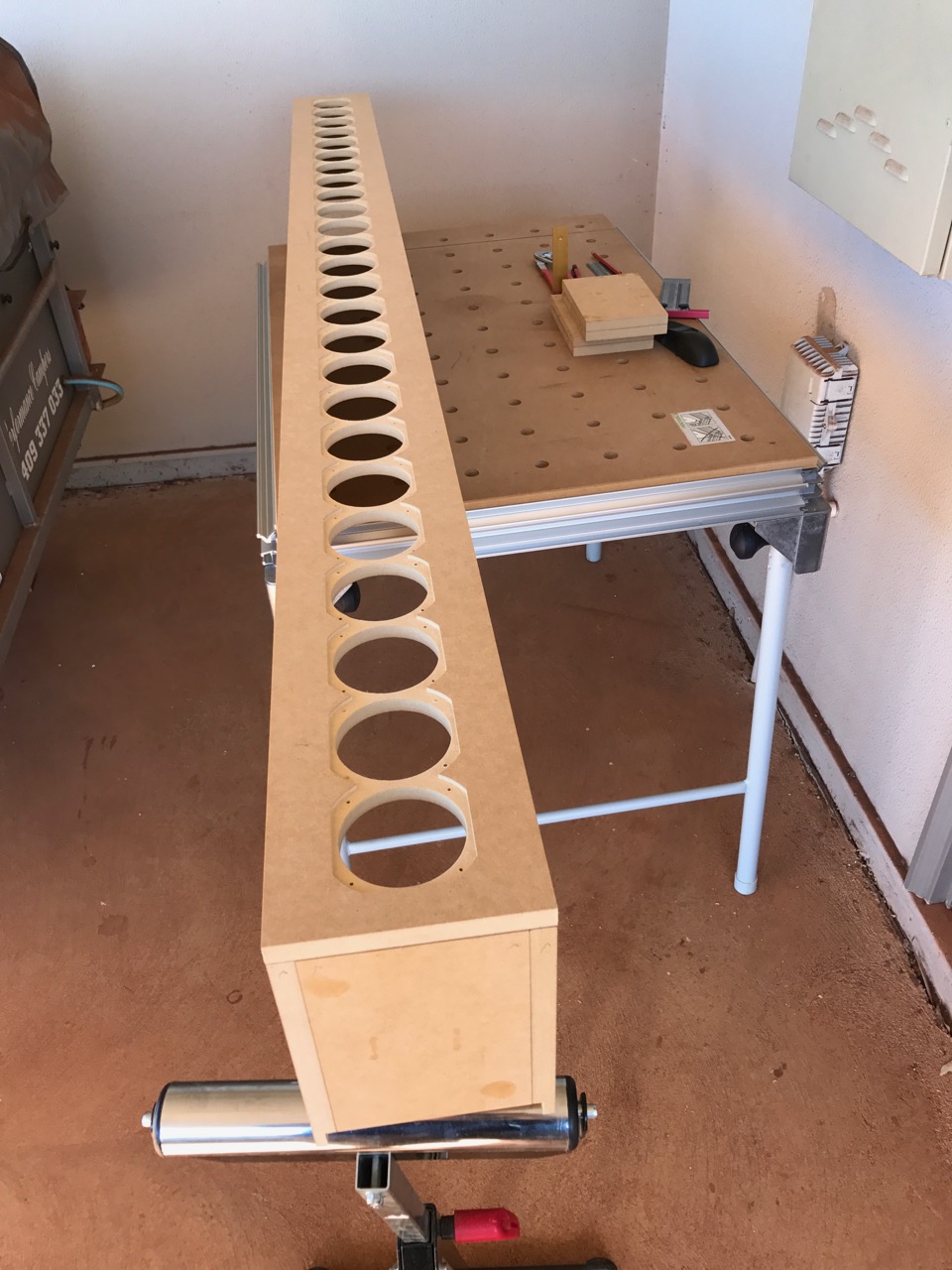
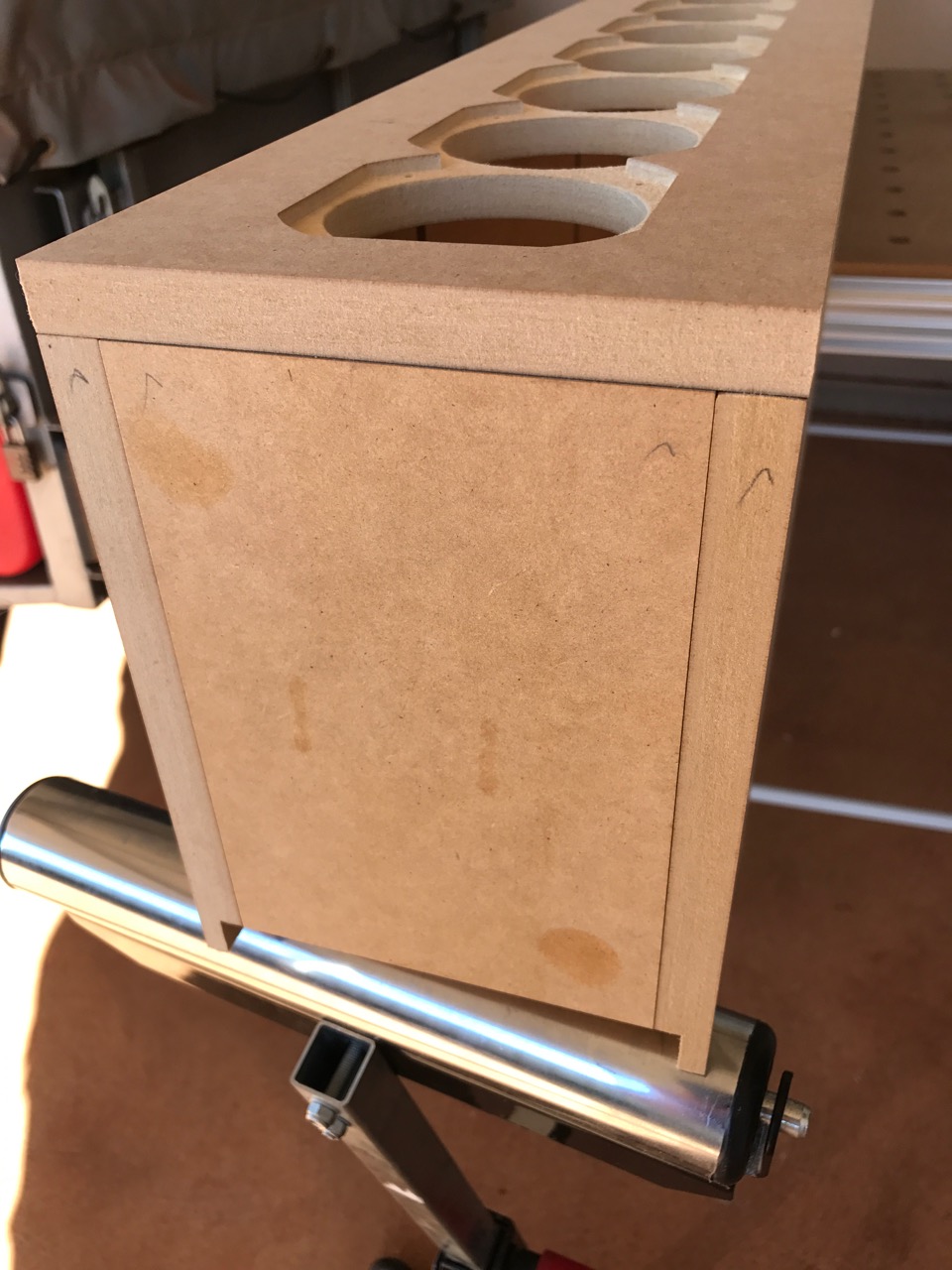
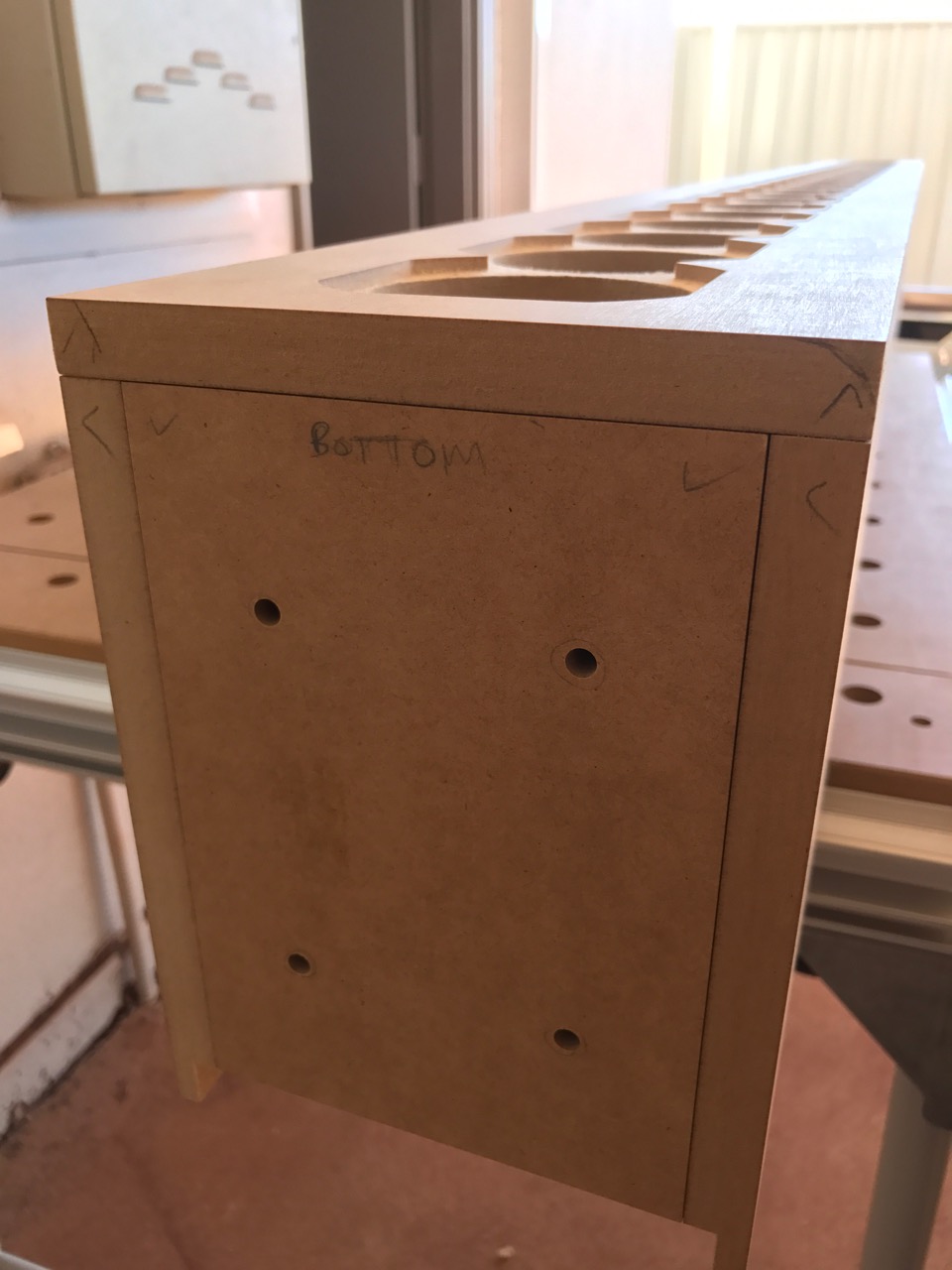
The second one is almost perfect considering it is held together only with a few dowels.
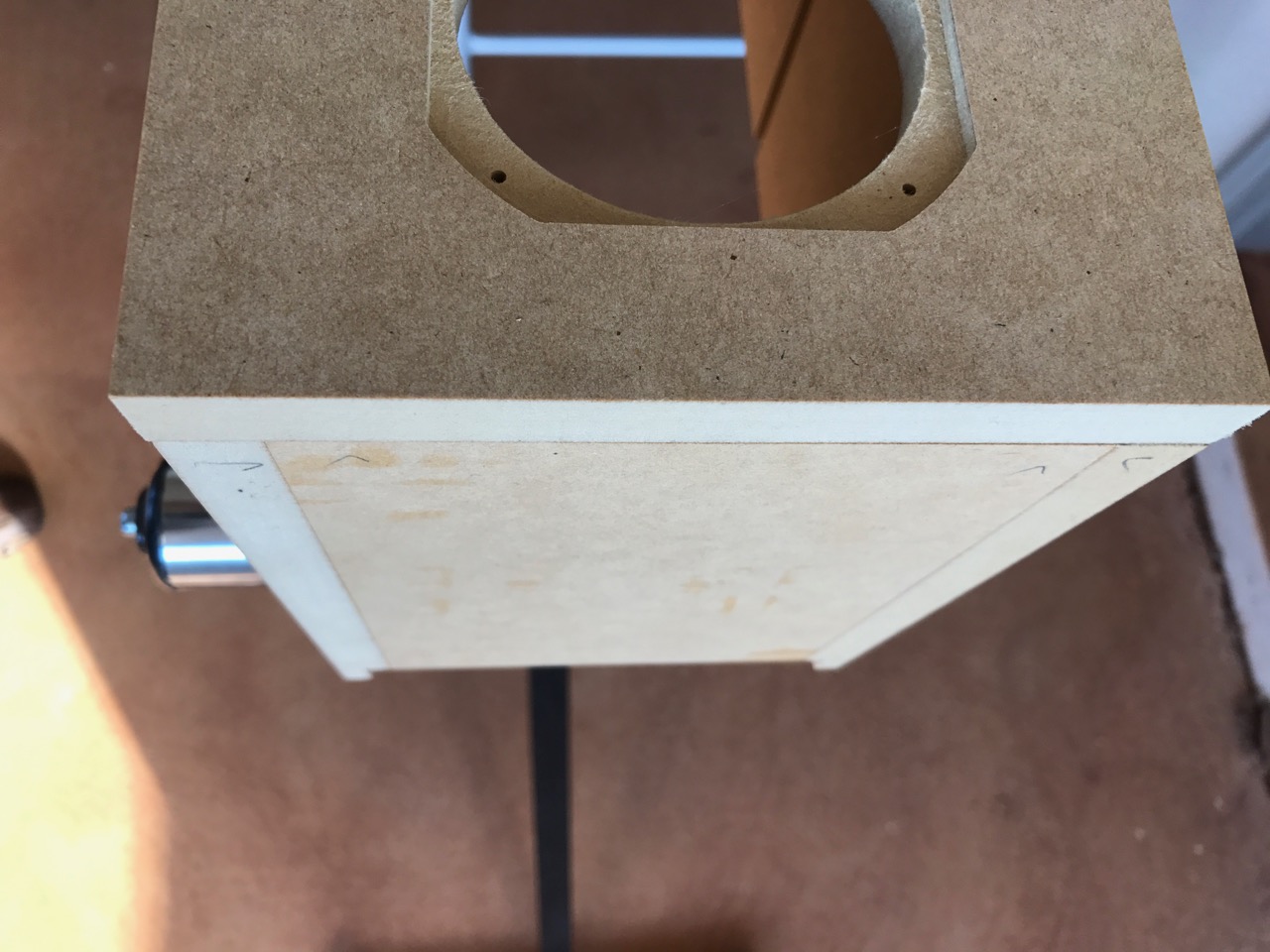
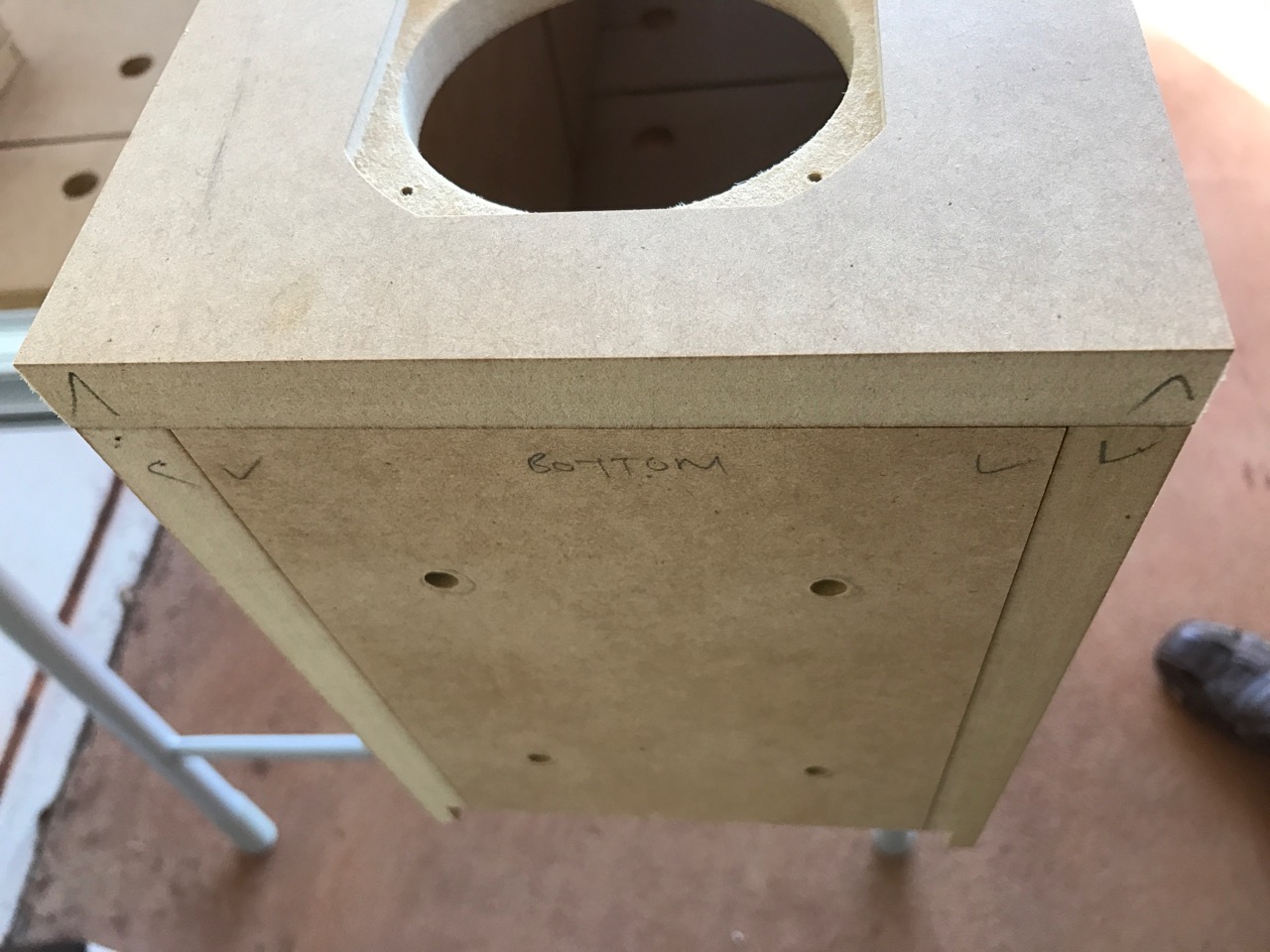
When gluing one of the bottom pieces I only used two dowels for alignment on the first one and it ended up not quite being square. A few minutes with a block plane made it flat again but the slight difference in size caused a slight mismatch in alignment on that tower. I will need to see what I can do to bring it all back together a bit better.
The second one is almost perfect considering it is held together only with a few dowels.
Attachments
I have been listening to the 30th Anniversary Collection by Whitesnake, interesting to see how the drum sound changes quite considerably over the three discs.
Not easy to find some good mixing/mastering examples from this band. I basically grew up on their music. The 30th Anniversary disk may be the best source for the 1987 album and later stuff and it's still lacking.
The other disks (like the 20th anniversary of SOTT) were even more disappointing.
The best sound I found from them were the older (still bluesy) albums on Japanese (UICY) CD pressings.
Not easy to find some good mixing/mastering examples from this band. I basically grew up on their music. The 30th Anniversary disk may be the best source for the 1987 album and later stuff and it's still lacking.
The other disks (like the 20th anniversary of SOTT) were even more disappointing.
The best sound I found from them were the older (still bluesy) albums on Japanese (UICY) CD pressings.
I don't have anything to compare it to and most of the tracks were not that familiar to me but I enjoyed listening to them.
Shake my Tree makes me think of what Led Zeppelin might have sounded like if they had carried on. When the drums come in it is quite Bonham esque even though the beat is much straighter. I really like the snare sound even though it's a polished Ludwig studio version
Some of the live tracks sound quite good to me too, they have a live atmosphere without sounding like they were recorded in a toilet.
- Home
- Loudspeakers
- Full Range
- Full Range TC9 Line Array CNC Cabinet
